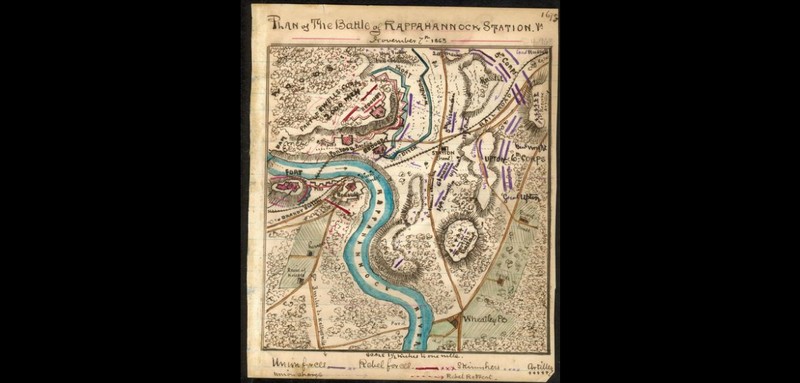Rappahannock Station Battlefield
Introduction
Text-to-speech Audio
The Rappahannock Station Battlefield is an area around the Rappahannock River located near Remington, Virginia in Fauquier County. This area was the site of two battles between the Union and Confederate Armies that occurred in 1862 and 1863. There are remnants of each armies' natural fortifications still located along the river area. The last battle that occurred in this area was an important event in determining the future outcome of the Civil War.
Images
A plan of the Battle of Rappahannock Station on November 7, 1863

First Battle of Rappahannock Station - August 22-25, 1862
.jpg)
Backstory and Context
Text-to-speech Audio
The Rappahannock Station was the site of two Civil War battles that happened on August 22nd through the 25th in 1862, and again on November 7, 1863. In both battles, the Union army won against the Confederates. It is the last battle in November 1863 that had a major impact in the history of the Civl War that pushed Union forces closer to victory.
General Robert E. Lee was the head leader for the Confederate forces at each battle. The first battle at Rappahannock Station was part of a long skirmish between Lee and General John Pope who lead Union forces during the Peninsula Campaign. Lee lost the first battle and then reorganized another strike against the Union army. The second battle that occurred in November, 1863 was between Lee's forces and Major General George G. Meade who lead a section of the Union army known as the Army of the Potomac. He was pushed by Washington to make another attack on Lee's army in Virginia. Each side had about 2000 soldiers and at the end of the conflict, the Confederates suffered the most casualties with losing about 1,674 out of 2,093 men.
The reason why the second battle at Rappahannock Station was a major event was due to what happened in the conflict and the significance. General Lee had placed his troops in a defensive position on the north side of the Rappahannock river. This created problems for Lee's defensive strategy as the original bridge, the Orange and Alexandria Railroad bridge, was destroyed in the previous battle and Lee's attempts to create a temporary bridge with a pontoon only limited access and slowed the possibilities of speedy reinforcement. General Robert E. Lee's mistake in strategy helped to aid the Union. This strategy caused major losses when the Meade's forces attack with surprise and force back the Confederates which caused the Union army to succeed without too many of their own casualties. Rappahannock station is significant as this was the site of the last battle of the Bristoe Campaign. Today, more than 869 acres of the Rappahannock Station battlefield is preserved by the American Battlefield Trust.
Cite This Entry
Allie C. Smith. "Rappahannock Station Battlefield." Clio: Your Guide to History. December 1, 2021. Accessed April 8, 2025. https://theclio.com/entry/139261
Sources
Gottfried, Bradley M. The Maps of the Bristoe Station and Mine Run Campaigns: An Atlas of the Battles and Movements in the Eastern Theater After Gettysburg, Including Rappahannock Station, Kelly's Ford, and Morton's Ford, July 1863- February 1864. Havertown: Savas Beatie, 2013. Ebscohost.
“Rappahannock Station, Virginia.” 2013. Civil War Times, December 2014.
American Battlefield Trust. "Rappahannock Station." Accessed September 15, 2021. https://www.battlefields.org/learn/civil-war/battles/rappahannock-station.
https://www.loc.gov/item/gvhs01.vhs00167/
https://www.battlefields.org/learn/maps/battle-rappahannock-station-august-22-25-1862

